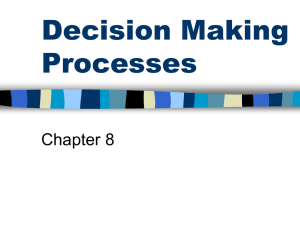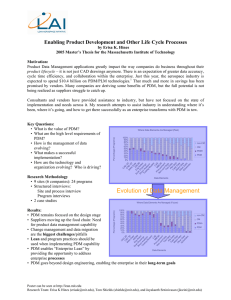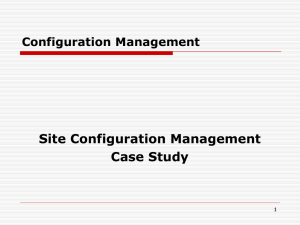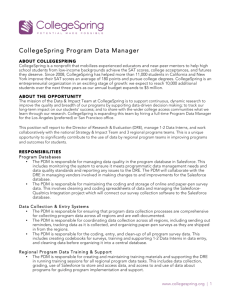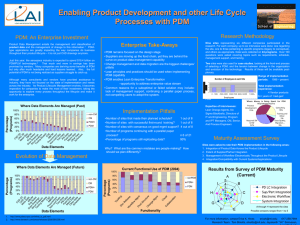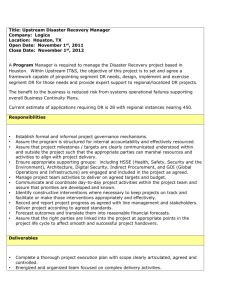IT Enabled Enterprise Transformation: Perspectives Using Product Data Management
advertisement
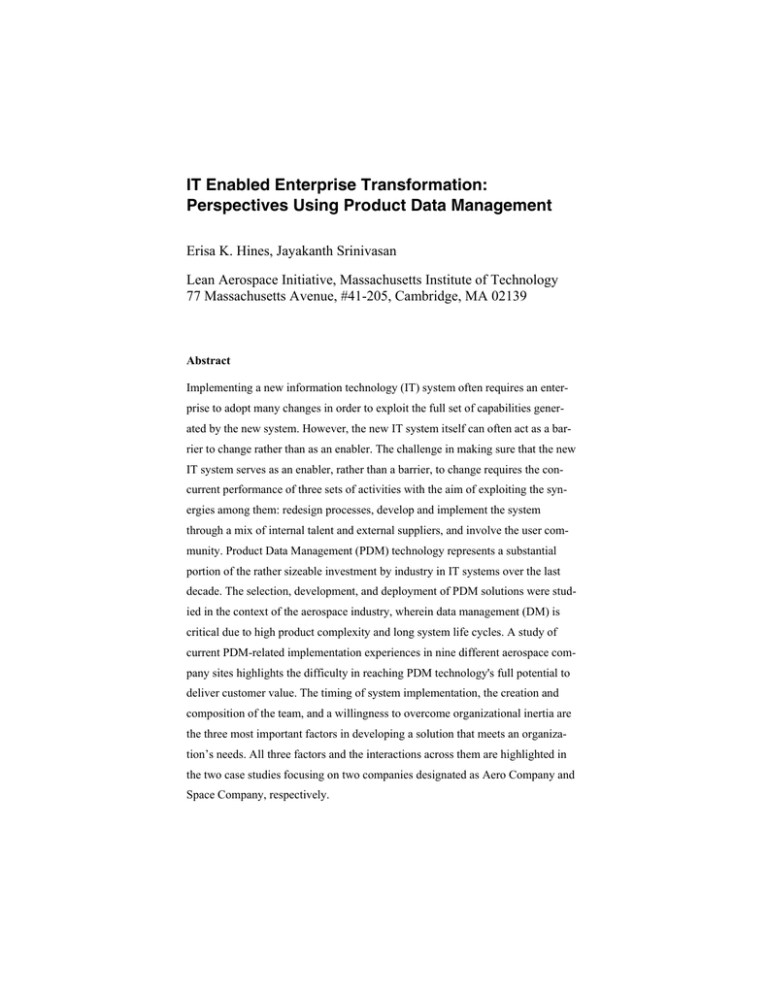
IT Enabled Enterprise Transformation: Perspectives Using Product Data Management Erisa K. Hines, Jayakanth Srinivasan Lean Aerospace Initiative, Massachusetts Institute of Technology 77 Massachusetts Avenue, #41-205, Cambridge, MA 02139 Abstract Implementing a new information technology (IT) system often requires an enterprise to adopt many changes in order to exploit the full set of capabilities generated by the new system. However, the new IT system itself can often act as a barrier to change rather than as an enabler. The challenge in making sure that the new IT system serves as an enabler, rather than a barrier, to change requires the concurrent performance of three sets of activities with the aim of exploiting the synergies among them: redesign processes, develop and implement the system through a mix of internal talent and external suppliers, and involve the user community. Product Data Management (PDM) technology represents a substantial portion of the rather sizeable investment by industry in IT systems over the last decade. The selection, development, and deployment of PDM solutions were studied in the context of the aerospace industry, wherein data management (DM) is critical due to high product complexity and long system life cycles. A study of current PDM-related implementation experiences in nine different aerospace company sites highlights the difficulty in reaching PDM technology's full potential to deliver customer value. The timing of system implementation, the creation and composition of the team, and a willingness to overcome organizational inertia are the three most important factors in developing a solution that meets an organization’s needs. All three factors and the interactions across them are highlighted in the two case studies focusing on two companies designated as Aero Company and Space Company, respectively. 2 Introduction Information and Communication technologies (ICT) have radically altered the way enterprises operate in today’s turbulent environment. They not only contribute in part to this environment through increased information availability to customers but also provide a means of ameliorating the uncertainty associated with a fast-clock speed operational environment by facilitating the integration of suppliers and partners across the enterprise. There are two aspects that need to be considered when an IT system is implemented across an enterprise: the ability of the system to meet current and future enterprise needs, and the ability of the enterprise to adapt to and leverage the capabilities of the implemented IT system. Both aspects have to be addressed synergistically to realize the benefits of the investment at the enterprise level. It has been widely documented that large-scale IT projects fail for reasons unrelated to the technical feasibility of the system or due to the reliability of its implementation (ST 1995, MK 1994). Additionally, it has been noted that good technology implementation, coupled with change management techniques, can substantially increase the probability of success (BL 1993). Markus and Benjamin (MB 1997) advance the Magic Bullet Theory of IT and Organization Change, in which enterprise change is seen as an expected outcome of the implementation of a powerful technology, only to highlight the fundamentally flawed nature of this theory; consequently, they identify alternative roles for IT change agents. Brynjolfsson and Hitt (BH 2000) argue that a significant component of the value of an IT system arises from the ability to enable complementary organizational investments, such as business processes and work practices. Our paper provides further case-based validation for that argument. CIMdata (CIM 2003) defines Product Lifecycle Management (PLM), from the perspective of a provider of PDM technology, as “a strategic business approach that applies a consistent set of business solutions in support of the use of product definition information across an extended enterprise from concept to end of life – integrating people, process, business systems, and information”. The con- IT Enabled Enterprise Transformation: Perspectives Using Product Data Management 3 ceptual mapping of the evolution of PLM to the levels of enterprise transformation is shown in Figure 1. The figure follows the Venkataraman framework (VM 1994) for the enterprise reconfiguration that happens when IT systems are adopted. The historical roots of PLM can be traced to computer-aided design (CAD) data management, which enables an enterprise to gain cost savings through the use of a centralized data vault. The impact of CAD-related data management was felt only within the design process. The PDM technology that followed had the potential to enable better design data flow across the enterprise. Its potential impact encompasses both evolutionary change involving work flow improvements during the design phase and revolutionary change through integration of design and manufacturing processes. PLM as it is currently defined requires revolutionary change to enable the seamless flow of product data across the entire lifecycle from design, all the way through product retirement. Increasing Enterprise Value High Lean Enterprise Most aerospace companies are still here. Enterprise Capability Business Solutions Enterprise Return } } Effectiveness Enterprise Agility Business Applications Process Focus Revolutionary levels Evolutionary levels Standardized Toolkits Functional Focus Custom Implementations Data/Technology Integration Quality Focus Localized Exploitation Cost Focus Low 1985 CAD Data Management 1990 1995 Product Data Management 2000 Efficiency Automate 2005 Product Lifecycle Management Figure 1: PDM in the context of enterprise transformation Unlike other industries in which product data flows only up to the distribution stage, aerospace requires product data to be managed through a system’s lifecycle, until its retirement. There are three motivating factors for PLM in aerospace: • Products have long lifecycles (up to 90+ years) and sustainment is often carried out not by the original manufacturer but other organizations specializing in sustainment activities. 4 • Customer and/or government agency visibility throughout the product lifecycle is often required. • Potential cost savings in process and tool standardization, and seamless integration between IT systems. There has been significant research into DM and its associated technologies. Abramovici and Sieg (AS 2001), and Hameri and Nihitilä (HN 1998) both provide an overview of the evolution of PDM/PLM. However, there has been little research highlighting the current state of PDM/PLM within the aerospace industry. The question of what impediments, if any, were faced by specific companies in implementing the system and how they were overcome in accomplishing ultimately successful implementation has remained an open question. This paper attempts to bridge that gap, providing insight into both the current state of DM within the US aerospace industry, and the expected trajectory of change based on the survey findings. The case-based narratives of IT-enabled change provide insight into the cultural and organizational challenges that lie ahead. Research Design The key research questions were identified through a one-day workshop at MIT, involving LAI consortium members. The workshop participants were selected to represent both prime contractors and suppliers of PDM technologies and services. In addition, the participants had PDM implementation initiatives at various stages of progress and maturity. This was done to get an accurate picture of the challenges faced at various phases of PDM implementation. During the workshop, a focused and representative list of the most pressing questions faced by the industry framed the research agenda. The questions included: o What are the high-level requirements for PDM and how are they implemented? o What are the success factors in implementing PDM at various stages of the implementation process? IT Enabled Enterprise Transformation: Perspectives Using Product Data Management 5 Given the questions and relevant literature, the research lent itself to an exploratory and descriptive methodology. It was decided that a two-phase approach should be taken. Phase one would consist of a structured interview process to gather initial data. Case studies would comprise phase two, an opportunity to further explore specific questions identified in phase one. Phase One Overall, nine company sites representing six different companies were visited. Sites were chosen based on having current or recent PDM-implementation activities. A broad range of company types was desired in order to represent the aerospace industry so prime contractors, suppliers and federally funded research and development centers (FFRDC) were present in the sample. Structured interviews were administered at each location at both the site and program level. More than 50 questions were asked each interviewee, covering a broad range of topics related to their PDM system’s capabilities, implementation approaches and experiences with the technology and user communities. The questions were developed from the workshop proceedings, reviewed by the team, and piloted at two sites prior to data collection. Interviewees at the site level were exclusively directors and senior managers in the engineering or IT organization. Interviewees at the program level were predominantly program managers and chief engineers. Phase Two Based on the findings from the initial interview data, two new questions were posed for exploration using the case studies. These were: 1. What was the initial tool selection process? 2. How are the technology and organization evolving over time? Two companies were chosen for the case studies, based on their disparate experiences and company type. The two companies highlighted very different patterns of progress in terms of both the initial selection decision processes and the subsequent evolution of the im- 6 plementation processes, as well as in terms of degrees of eventual implementation success achieved. The results reported here highlight interim findings. Phase One Survey Findings For each site, at least one interview was at the site level and up to three at the program level. Some of the results highlight patterns of PDM implementation within the companies surveyed. Several interesting patterns also emerged regarding the approach taken to major PDM implementation efforts and how the outcome seemed to be shaped by both the context and various challenges faced during the implementation process. 90% 80% 70% non-CM 60% CM 50% 40% PDM+ 30% PDM 20% 10% 0% C C AD 2D A M D et 3D a D a E ta Sc En B O an g M St Dr Not r u aw es c To t A ing ol nal s i n ys g M is od el s C A Pr M E o B N cu OM on re -c m o n en t f T e Da st ta D PM a t a Fi D el at a M dD ai at O nt D a th a e t Sc r D a he ata du le s Percentage (Programs) 100% Data Elements Figure 2: Pre-Transformation State of Data Management The data presented in Figure 2 and Figure 3 were collected from the twenty programs interviewed. These two figures capture the four main approaches employed to product data management: only PDM, PDM and some additional method, configuration management (CM), or without any formal configuration management. Figure2 IT Enabled Enterprise Transformation: Perspectives Using Product Data Management 7 illustrates the state of product data management prior to the implementation of a new PDM system. The use of PDM in the surveyed programs covered less than thirty percent of the total data managed beyond the creation of the Manufacturing Bill of Materials. This highlights the disconnect that existed between the engineering and manufacturing phases of system development. Figure illustrates the expected state of product data management after the implementation of a new PDM system. A key finding from the survey is the increased use of PDM in managing engineering design data. The flow of data to the manufacturing and support phases through the use of PDM still remains largely unexploited. Even in the case of new PDM implementation efforts, the scope of data management in terms of encompassing other functions beyond engineering seems to be seriously limited. Therefore, future PDM implementation initiatives should focus more attention to the ability of transferring data to other downstream enterprise functions. Figure 3 indicates a potential shift over the next few years to data management covering more of the downstream enterprise functions including manufacturing and sustainment. One of the implementation-related questions posed at the site level covered the approaches used to training the site personnel and how success was perceived. Although six out of eight responses answered “yes” and one answered “functional” when asked whether the interviewees considered their training to have been successful, the “yes” response was always accompanied by a “sort of” or a candid “no.” A clear pattern pattern emerging from the interviews indicated that more effort needs to be spent in communicating the significance to the user community of what they are about to experience. As described by a director of design engineering, “Where [training] has been a success, it was because the people understood the impact. This isn't just a PDM - it's their new job. In other instances, some heard but didn't listen.” Others commented as well, saying that making the transition more ‘real’ to the user community would have lessened the resistance. 100% 90% 80% 70% non-CM 60% CM 50% 40% PDM+ 30% PDM 20% 10% 0% C C AD 2 A D M D et 3D a D a E ta Sc En B O g an M St Dr Not ru aw es ct To A ing ol nal s i n ys g M is od el s C A Pr M E o B N cu O on re M -c m o n en t f T e Da st ta D PM a ta Fi D el at M dD a ai a n t O tD a th a er ta Sc D he at du a le s Percentage (Programs) 8 Data Elements Figure 3: Post-Transformation State of Data Management From the interviews, there were several themes like those above describing typical implementation processes that tend to be very challenging to execute. The challenges cited raised some questions about how the software selected for implementation was chosen in the first place. They further raised other questions, such as whether certain changes were forced upon the organization or whether these changes were the results of software system being implemented. These and related early questions led to the case studies. Phase Two Case Study Findings The two companies selected for the case studies were based on their different approaches to PDM, the different sectors within which they operated, and the changes enabled by PDM. Company Aero is a business unit of an aerospace company that has been in the weapon platforms business dating back to the 1960s. Company Space is a research and development establishment, specializing in spacecraft, space systems and mission operations, dating back to the early 1940s. IT Enabled Enterprise Transformation: Perspectives Using Product Data Management 9 Successful Enterprise Transformation Case Study Aero’s history of mergers, acquisitions and an arguably unstable stream of government contracts had placed it in the threatened position of being shut down. For political reasons, shutting down was not an option for the corporation, hence Aero as a business unit was challenged to reduce its operating costs by 20%. Facing a ‘burning platform’, Aero’s leadership supplemented its organization with an experienced team from a sister business unit. The management of Aero’s bill of material (BOM) was identified by the experienced outsiders as the focal point of concern. Process change enabled through PDM technology was prescribed as the solution Aero needed. The team understood that the transition would not simply be a new IT system. Led within the engineering organization, the processes were fundamentally re-evaluated and redesigned; interfaces across functional disciplines and external stakeholders were identified and addressed; users were required to use the new system, they avoided any training and found loopholes to continue using the legacy system. Perhaps most important, the leadership at the “burning platform” site was given the budgetary support and authoritative backing to make drastic changes. After a series of three incremental implementation efforts, Aero had transformed the way it did business. It went from a loss center to the top-performing center within its line of business across the parent company. Its major customer now has complete visibility into Aero’s processes and has instituted having such a capability as a requirement in its other contracts. Aero is able to share digital data across the company as well as with its supplier network and customers. Most important, it now can track its cost and schedule drivers as a reconcilable, fully managed BOM drives the company’s product lifecycle. Aero is currently transferring its knowledge and expertise to a remote design center to enable a similar transformation. Aero continues to make improvements in its processes and capabilities. It also continues to change its existing culture as it strives to 10 make further progress with its PDM-implementation related efforts. These implementation efforts have nevertheless fundamentally changed Aero for the better and enabled it to be prepared to address the challenges ahead. Struggling Enterprise Transformation Case Study Space’s culture has remained fairly static over its history. It quickly established its place in the industry as a strong research and development center, producing small quantities of specialized products. Space is mostly comprised of master’s- and PhD-level employees who are largely self-driven and motivated. However, it has a diluted management culture, perhaps resulting from its distributed leadership structure. Its business needs also differ sufficiently from others in the aerospace industry, such that having a robust DM capability has not been seen as a high priority. Space’s initial PDM efforts were driven by the need to replace the retiring director of its DM group, framing its ‘burning platform’. The decision was made to automate configuration management of drawings. The assignment continued to reside in the IT organization, with little attention paid to it by upper management. The initial implementation consisted of the IT team selecting a PDM solution that could not only manage drawings but also automate many additional processes. It launched the solution without involving any of the users or entertaining their input. Given Space’s culture, the users essentially boycotted the system. Over a period of six years, Space’s PDM efforts struggled due to management changes, reorganizations, and an undefined internal IT mandate. Five years ago, Space declared that IT was not a core competency, its IT/PDM management stabilized, and a new, defined PDM effort emerged. Since then, it has successfully piloted its new system, involved the participation of the affected programs within the company, and begun rolling out the new IT/PDM capability. As Space’s environment has become more competitive as well as more IT Enabled Enterprise Transformation: Perspectives Using Product Data Management 11 collaborative, its PDM capabilities have helped the company to meet these emerging. Space continues to struggle, however, with its culture. It is a long way from obtaining the gains made by Aero, mainly due to the lack of value placed on the capability by upper management. Space’s transformation efforts as an enterprise will continue to be restrained/inhibited as long as the culture is given free reign over its programs’ IT choices and management does not provide stronger budgetary and authoritative support for the effort. Conclusions The enterprises studied here still have a way to go before product data can be used successfully across the entire lifecycle. PDM/PLM systems can provide strategic capabilities to the enterprise in terms of enabling faster responses to customer needs, and providing product knowledge capture within the enterprise. Successful leveraging of these capabilities arises from understanding the need for product data management, assessing the current internal enterprise capabilities and those provided by vendors, managing the process change that results from implementing the system, and keeping the implementation current. There are technical, organizational and cultural challenges that arise from implementing a new IT system; PDM systems provide an excellent illustrative example of these challenges. Our survey data reflects the increased adoption of product data management within the aerospace industry, and highlights the expected change trajectory over the next five years. A snapshot from nominal data regarding training experience helps to illustrate one of the typical but highly critical decision points. This and others such as the composition of the PDM development and implementation team have the potential to cripple an otherwise well-planned implementation strategy. The two cases presented represent different contexts and progressions in enterprise IT adoption. The main findings from the cases were: 12 • • • • One size does not fit all: The two cases presented used contrasting IT implementation approaches. Their strategies were a function of resource availability, management commitment and system understanding. The approach adopted must reflect limitations imposed by the organization, technology and culture. Authority to transform the enterprise: The team given responsibility for designing and implementing the system must be given authority and the requisite budget to drive change. Gaining user commitment: Not communicating the criticality of transitioning to the new system is a common stumbling block in gaining user commitment. This requires user involvement in the process redesign as well as training of end users in the process changes and in using the tool itself. Managing process evolution: A successful execution requires management of process changes before, during and after system implementation. References Abramovici, M. and O. Sieg. Status and Development Trends of Product Lifecycle Management Systems, Proceedings of IPPD 2002 Wroclaw, Nov 21-22; Wroclaw, Poland. ISBN: 83-7085-667-5. Benjamin, R.I. and E. Levinson. "A Framework for Managing IT-Enabled Change," Sloan Management Review, Sum 1993; 34:23-33. Brynjolfsson, E. and L. Hitt. “Beyond Computation: Information Technology, Organizational Transformation and Business Performance,” Journal of Economic Perspectives, 2000, 14(4): 23-48. CIMdata, PDM to PLM: Growth of an Industry, March 2003. Hameri, Ari-Pekka and Jukka Nihtilä. “Product Data Management - Exploratory Study on State-of-the-Art in One-of-a-Kind Industry,” Computers in Industry, April 1998, 35(3):195-206. Liu, D. Tony and X. William Xu. “A Review of Web-Based Product Data Management Systems,” Computers in Industry, April 2001, 44(3): 251-262. Markus, M. Lynne and Benjamin, Robert I. “The Magic Bullet Theory in ITEnabled Transformation,” Sloan Management Review, Winter 1997; 38(2):55-68. Markus, M Lynne and M. Keil, "If We Build It, They Will Come: Designing Information Systems That Users Want to Use," Sloan Management Review, Summer 1994; 35:11-25. IT Enabled Enterprise Transformation: Perspectives Using Product Data Management 13 Robey, Daniel and Marie-Claude Boudreau. “Accounting for the Contradictory Organizational Consequences of Information Technology: Theoretical Directions and Methodological Implications,” Information Systems Research, Feb 1999, 10(2):167-185. Standish Group (1995): The CHAOS Report into Project Failure, The Standish Group International Inc. Available on-line at http://www.standishgroup.com/visitor/chaos.html Venkataraman, N. “IT-enabled business transformation: From Automation to Business Scope Redefinition,” Sloan Management Review, Winter 1994; 35(2): 73-87.
